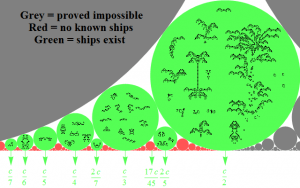Speed
The speed of a pattern is a measure of the number of generations that it takes for some effect to travel some given distance. Speeds are almost always measured in reference to the speed of light (or speed of life), denoted by c which, the fastest possible speed at which any effect can propagate. William Poundstone, in The Recursive Universe: Cosmic Complexity and the Limits of Scientific Knowledge, writes (p. 79; our emphasis)
| “ | […] Suppose a certain pattern is contained in a 100-by-100-pixel square. Everything outside the square is in the off state. No matter what the structure of the pattern, it can influence only the pixels bordering the square in the next generation. It will then be contained in a 102-by-102-pixel square. At very most, a pattern can grow one pixel per generation in any direction.
This is the maximum speed at which any form of information can be transmitted across the Life plane. It is the counterpart of the speed of light in the real world and is often called by that name. […] |
” |

Thus for first neighbor neighborhoods, such as the Moore and von Neumann neighbourhoods of range one, the speed of light is a rate of one cell per generation. Rules with extended neighbourhoods, such as Larger than Life rules, have higher speeds of light; other classes of cellular automata may have different speed of lights yet.
Spaceships

For spaceships, the speed describes the number of cells that it has been displaced by after it has gone through one period. Speed is reported in the form dc/p where d is the displacement and p is the period. It is most common to reduce this "fraction" to lowest terms. For example, even though the period of a lightweight spaceship is 4, it moves 2 cells during those generations, giving it a speed of 2c/4 = c/2.
For spaceships that move diagonally, speed is defined the same as above, but where "the number of cells that is has been displaced by" refers to the maximum of the x or y displacement; not their sum. So, for example, a glider has a speed of c/4, since it takes 4 generations to move one cell in the x direction and one cell in the y direction.
More formally, if a spaceship in any 2D cellular automaton is translated by (x,y) after n generations then its speed v may be defined as:
This definition can be generalized in a straightforward manner to cellular automata with dimension other than two.
See also
- List of important speeds
External links
- Spaceship at Wikipedia
- Speed of light (cellular automaton) at Wikipedia
- Speed of light at the Life Lexicon